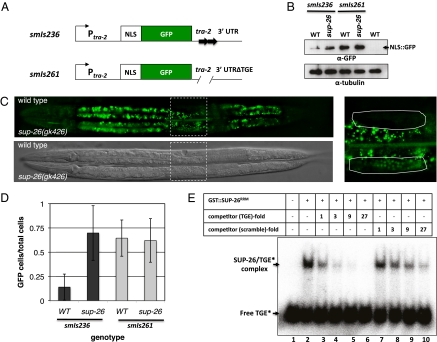Fig. 4.
SUP-26 represses tra-2 translation by binding to the TGE elements in tra-2 3′ UTR. (A) A schematic showing two tra-2 transcriptional fusions used to examine the role of TGEs in regulating tra-2 expression. A GFP with four copies of the SV40 nucleus localization signal (NLS) is under the control of the tra-2 promoter and 3′ UTR with or without the two TGEs (Methods). (B–D) Expression levels of NLS::GFP in wild-type and sup-26(gk426) hermaphrodite larvae carrying two different integrated arrays, smIs236 (Ptra-2NLS::GFP::3′UTRtra-2) and smIs261 [Ptra-2NLS::GFP::3′UTR(ΔTGE)tra-2], which lacks two TGEs. (B) One hundred larvae of the indicated genotype were analyzed by 12% SDS/PAGE and then by immunoblotting using an anti-GFP antibody or an anti-∂-tubulin antibody as described in Fig. 3C. (C) GFP and DIC images of representative L4 stage wild-type (Upper) and sup-26(gk426) (Lower) hermaphrodites carrying smIs236. The region indicated by the dashed box is enlarged on the right, and the uterine cells bounded by the dashed box were scored for NLS::GFP expression. (D) Percentages of uterine cells that expressed NLS::GFP in wild-type or sup-26(gk426) hermaphrodites carrying smIs236 or smIs261. Images of 15 animals from each strain were captured and scored blind of the genotype for uterine cells with NLS::GFP, which are expressed as a ratio over the total number of uterine cells scored. Error bars are SDs. (E) SUP-26 binds specifically to the TGE element. A 32P-labeled 28-nt TGE RNA oligonucleotide (1.8 pmol) was incubated with or without 2.1 pmol of purified GST::SUP-26RRM (lanes 1 and 2) in the presence or absence of increasing concentrations of unlabeled TGE RNA oligonucleotide (lanes 3–6) or an RNA oligonucleotide with a scrambled TGE sequence (lanes 7–10), whose concentrations are presented as folds of the 32P-labeled TGE. The reactions were resolved by 5% nondenaturing polyacrylamide gel (Methods).

